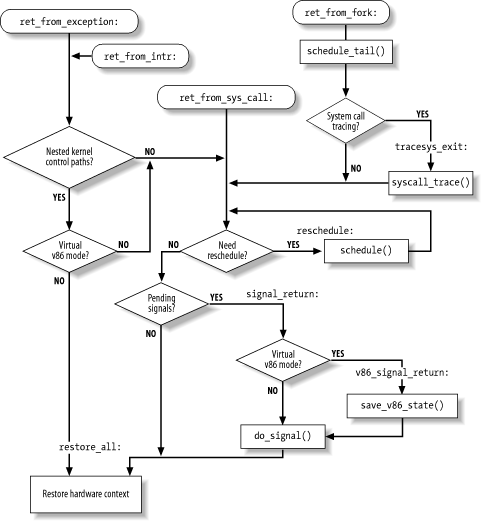We will finish the chapter by examining the termination phase of interrupt and exception handlers. Although the main objective is clear — namely, to resume execution of some program — several issues must be considered before doing it:
- Number of kernel control paths being concurrently executed
If there is just one, the CPU must switch back to User Mode.
- Pending process switch requests
If there is any request, the kernel must perform process scheduling; otherwise, control is returned to the current process.
- Pending signals
If a signal is sent to the current process, it must be handled.
The kernel assembly language code that accomplishes all these things
is not, technically speaking, a function, since control is never
returned to the functions that invoke it. It is a piece of code with
four different entry points called ret_from_intr,
ret_from_exception,
ret_from_sys_call, and
ret_from_fork. We will refer to it as four
different functions since this makes the description simpler, and we
shall refer quite often to the following three entry points as
functions:
-
ret_from_exception( ) Terminates all exceptions except the
0x80ones-
ret_from_intr( ) Terminates interrupt handlers
-
ret_from_sys_call( ) Terminates system calls (i.e., kernel control paths engendered by
0x80programmed exceptions)-
ret_from_fork( ) Terminates the
fork( ),vfork( ), orclone( )system calls (child only).
The general flow diagram with the corresponding four entry points is
illustrated in Figure 4-5. The
ret_from_exception( ) and ret_from_intr( ) entry points look the same in the picture, but they
aren’t. In the former case, the kernel knows the
descriptor of the process that caused the exception; in the latter
case, no process descriptor is associated with the interrupt. Besides
the labels corresponding to the entry points, a few others have been
added to allow you to relate the assembly language code more easily
to the flow diagram. Let’s now examine in detail how
the termination occurs in each case.
The ret_from_exception( ) function is essentially
equivalent to the following assembly language code:
ret_from_exception:
movl 0x30(%esp),%eax
movb 0x2C(%esp),%al
testl $(0x000200003),%eax
jne ret_from_sys_call
restore_all:
popl %ebx
popl %ecx
popl %edx
popl %esi
popl %edi
popl %ebp
popl %eax
popl %ds
popl %es
addl $4,%esp
iretThe values of the cs and eflags
registers, which were pushed on the stack when the exception
occurred, are used by the function to determine whether the
interrupted program was running in User Mode or if the VM flag of
eflags was set.[37] In either case, a jump is made
to the ret_from_sys_call( ) function. Otherwise,
the interrupted kernel control path is to be restarted. The function
loads the registers with the values saved by the
SAVE_ALL macro when the exception started, and the
function yields control to the interrupted program by executing the
iret instruction.
The ret_from_intr( ) function is essentially
equivalent to ret_from_exception( ):
ret_from_intr:
movl $0xffffe000,%ebx
andl %esp,%ebx
jmp ret_from_exceptionBefore invoking ret_from_exception( ),
ret_from_intr( ) loads in the
ebx register the address of the
current’s process descriptor (see
Section 3.2.2). This is necessary because
the ret_from_sys_call( ) function, which can be
invoked by ret_from_exception( ), expects to find
that address in ebx. On the other hand, when
ret_from_exception( ) starts, the
ebx register has already been loaded with
current’s address by the
exception handler (see Section 4.5.1 earlier in this chapter).
The ret_from_sys_call( ) function is equivalent to
the following assembly language code:
ret_from_sys_call:
cli
cmpl $0,20(%ebx)
jne reschedule
cmpl $0,8(%ebx)
jne signal_return
jmp restore_allAs we said previously, the ebx register points to
the current process descriptor; within that
descriptor, the need_resched field is at offset
20, which is checked by the first cmpl
instruction. Therefore, if the need_resched field
is 1, the schedule( ) function is invoked to
perform a process switch:
reschedule:
call schedule
jmp ret_from_sys_callThe offset of the sigpending field inside the
process descriptor is 8. If it is null, current
resumes execution in User Mode by restoring the hardware context of
the process saved on the stack. Otherwise, the function jumps to
signal_return to process the pending signals of
current:
signal_return:
sti
testl $(0x00020000),0x30(%esp)
movl %esp,%eax
jne v86_signal_return
xorl %edx,%edx
call do_signal
jmp restore_all
v86_signal_return:
call save_v86_state
movl %eax,%esp
xorl %edx,%edx
call do_signal
jmp restore_allIf the interrupted process was in VM86 mode, the
save_v86_state( ) function is invoked. The
do_signal( ) function (see Chapter 10) is then invoked to handle the pending
signals. Finally, current can resume execution in
User Mode.
The ret_from_fork( ) function is executed by the
child process right after its creation through a fork( ), vfork( ), or clone( ) system call (see Section 3.4.1). It is essentially equivalent to the
following assembly language code:
ret_from_fork:
pushl %ebx
call schedule_tail
addl $4,%esp
movl $0xffffe000,%ebx
andl %esp,%ebx
testb $0x02,24(%ebx)
jne tracesys_exit
jmp ret_from_sys_call
tracesys_exit:
call syscall_trace
jmp ret_from_sys_callInitially, the ebx register stores the address of
the descriptor of the process being replaced by the cild (usually the parent’s process descriptor); this value is
passed to the schedule_tail( ) function as a
parameter (see Chapter 11). When that function
returns, ebx is reloaded with the
current’s process descriptor
address. Then the ret_from_fork( ) function checks
the value of the ptrace field of the
current (at offset 24 of the process descriptor).
If the field is not null, the fork( ),
vfork( ), or clone( ) system
call is traced, so the syscall_trace( ) function
is invoked to notify the debugging process. We give more details on
system call tracing in Chapter 9.
[37] This flag allows programs to be executed in Virtual-8086 Mode; see the Pentium manuals for more details.
Get Understanding the Linux Kernel, Second Edition now with the O’Reilly learning platform.
O’Reilly members experience books, live events, courses curated by job role, and more from O’Reilly and nearly 200 top publishers.


